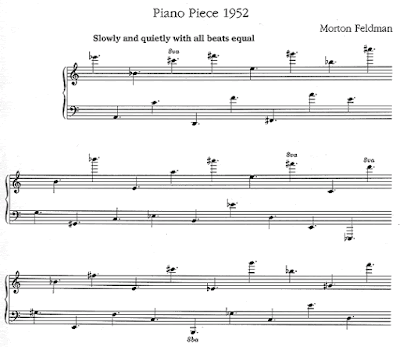 |
| Morton Feldman (1926 - 1987) |
Morton Feldman was associated with a group of experimental New York composers that included John Cage, Christian Wolfe and Earle Brown. Like the others, Feldman's compositions used the idea of indeterminacy, or making scores much less specific as to pitches, rhythms and so on. Around 1970 he gave up the use of radical indeterminacy and began to write music where the results were more clearly indicated. In 1973 he was appointed professor of composition at SUNY Buffalo where a Canadian composer friend of mine did a doctorate in composition under his direction. Prior to that he supported himself as a full-time employee at his family's textile business. The very last assignment I completed in a 20th century theory and analysis seminar was on Feldman's piece Rothko Chapel. Sadly, Morton Feldman died quite young, at age 61, from pancreatic cancer.
While John Cage seems to get most of the public attention, and Christian Wolfe and Earle Brown seem to have faded away entirely, I have the feeling that the most interesting composer in this group was Morton Feldman. Let's look at a couple of examples of his notation. This is a piece for orchestra from 1967:
A piano piece from 1952:
Later scores are more conventional with time signatures:
I can't find the score to Rothko Chapel online, but here is a photo of the interior of the chapel itself:
Rothko Chapel is a non-denominational chapel in Houston that is not only a place of worship or meditation, but also an important gallery of art. The interior contains fourteen paintings by Mark Rothko. The composition by Morton Feldman was inspired by and written to be performed in the chapel.
Let's have a listen to the piece, which was composed in 1971 for the very unusual ensemble of soprano, alto, choir, percussion, celesta and viola:
Like much of Feldman's music, the dynamics are often quite soft. In his later years he began writing very long pieces such as Violin and String Quartet (1985, around 2 hours), For Philip Guston (1984, around four hours) and, most extreme, the String Quartet II (1983, which is over six hours long without a break.)





7 comments:
I find some of his music gorgeous, but you have to be in the mood. The polemics, not so much.
Oh, for sure. I wasn't aware of much in the way of polemics coming from Feldman--what did you have in mind?
So Rothko Chapel is from 1971; have gotten around to listening tonight at last, well, in fifteen minutes. Am I hearing indeterminacy mostly, not so much, not at all? Heard the opening bars earlier and it certainly begins pleasantly enough. I suppose I ought to listen to some of the early indubitably indeterminate music.
The most beautiful music is near the end where you will hear an actual lovely melody.
No, there is no indeterminacy in this piece, he moved away from that in 1970.
iM A BAD WRITER FROM bUENOS aIRES, SO i'L LIMIT MYSELF TO SAY THAT FELDMAN IS THE MAN AND THAT HE KICKS ASS AND HIS MUSIC IS STRANGE, ILLUMINATED, AND BEAUTIFUL. IF I EVER GET THE CHANCE TO LEARN NOTATION, I'L WRITE DOWN AND MAKE MY OWN MUSIC IN A PROPER WAY.
THANKS FOR THE POST, CHEERS!
Hi Fernando and welcome to the Music Salon. "Strange, illuminated and beautiful" is not a bad way to describe Morton Feldman's music.
Post a Comment